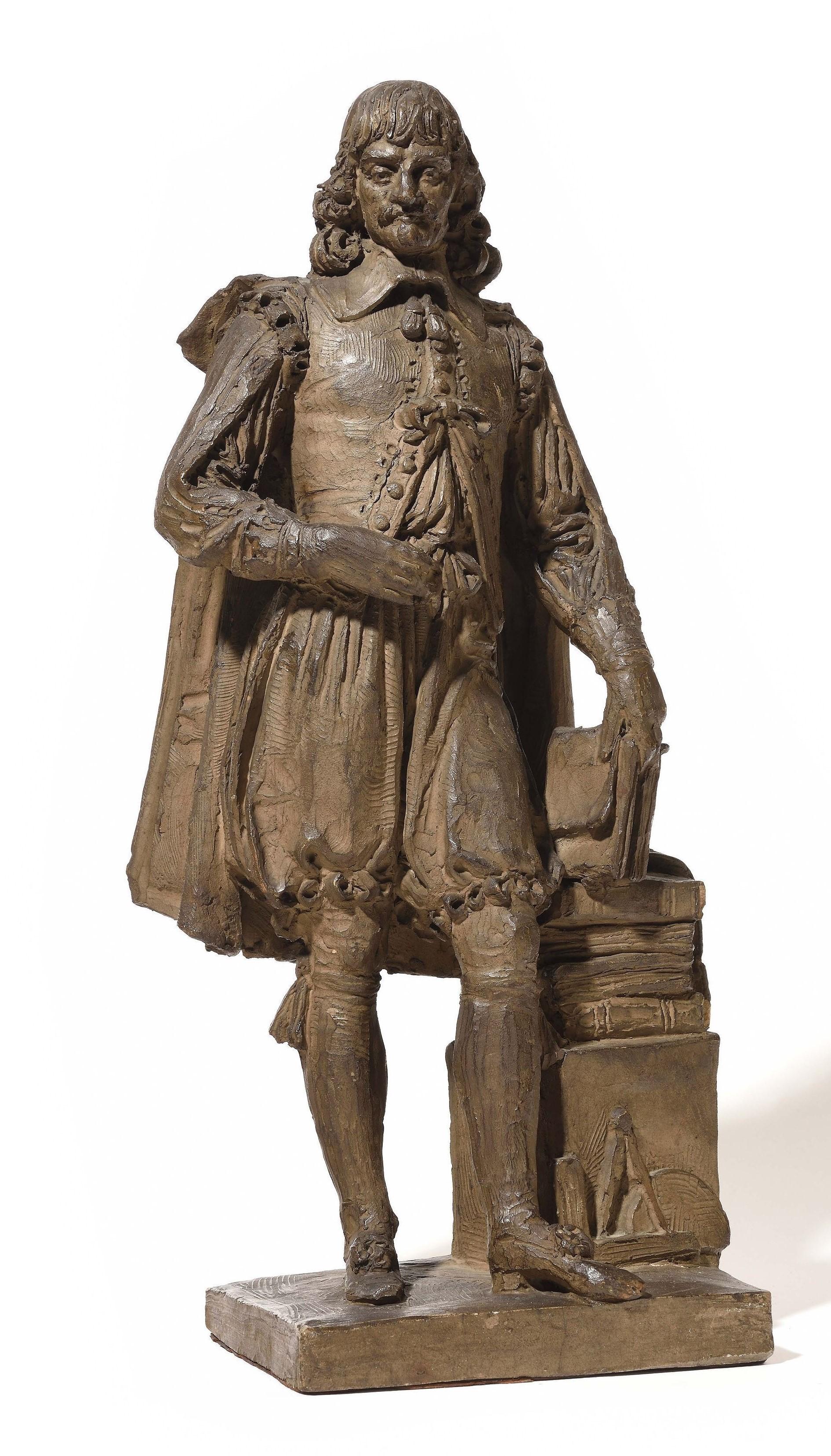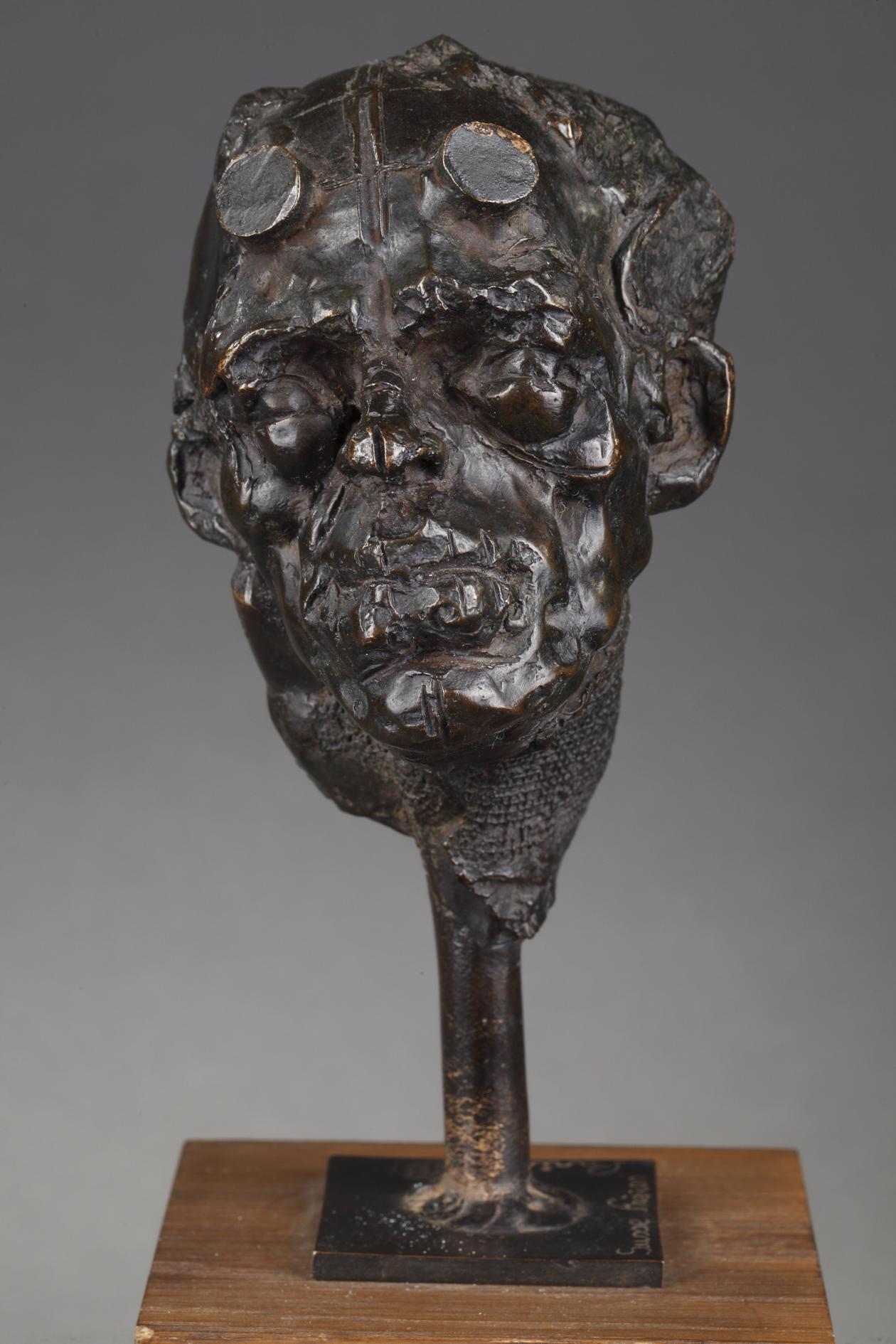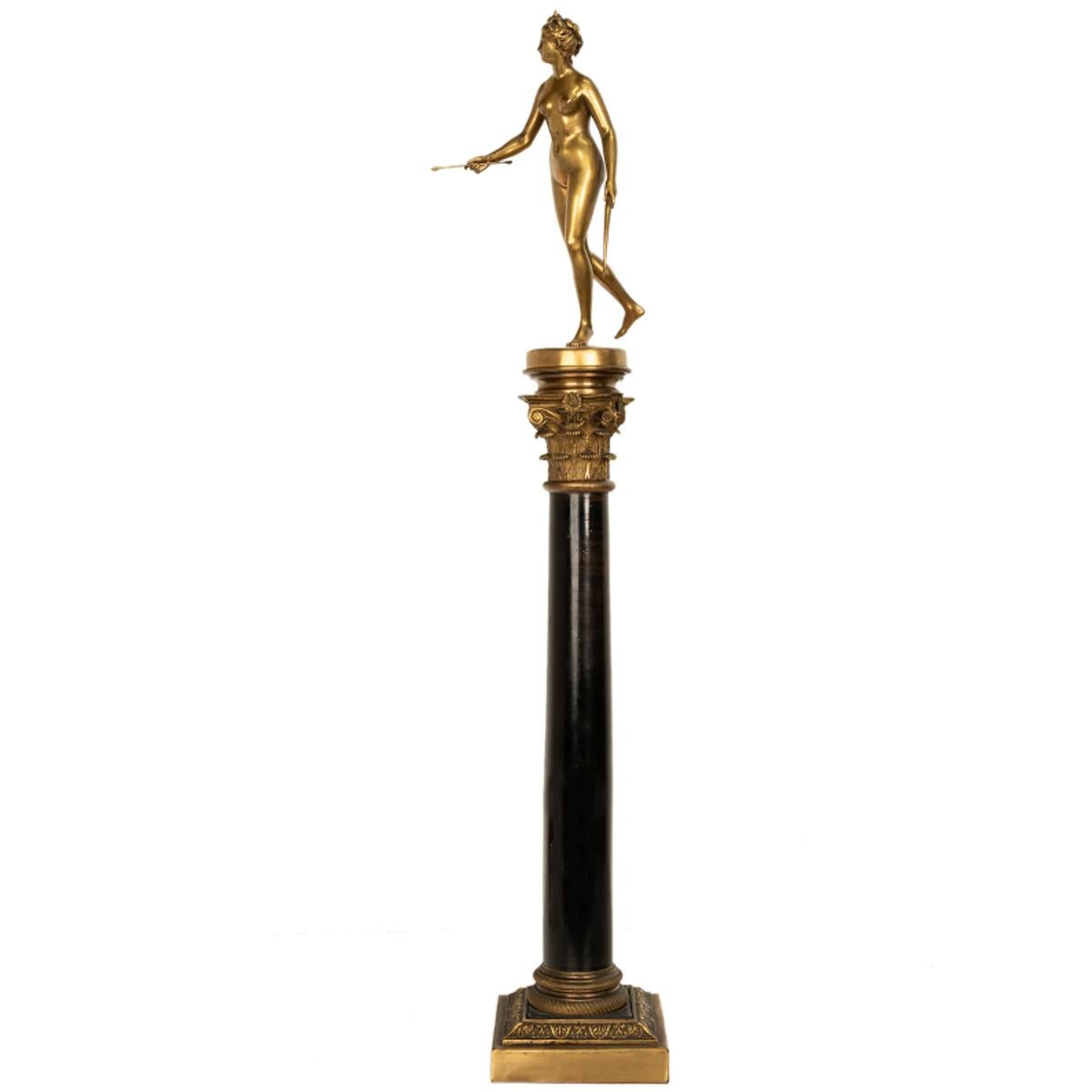Items Similar to General Cambronne bust in "Hermès" - Att. to E-E Suc (1802-1855)
Want more images or videos?
Request additional images or videos from the seller
1 of 5
General Cambronne bust in "Hermès" - Att. to E-E Suc (1802-1855)1842
1842
About the Item
Attributed to Etienne-Édouard SUC
(Lorient, 1802 – Nantes, 1855)
Bust "in Hermès" of General Cambronne
Plaster
H. 59 cm
1842
Provenance: probably Madame Cambronne (1773-1854), widow of the general
Our bust of General Cambronne (1770-1842) could be an interesting rediscovery of a work by the Breton sculptor Etienne-Édouard Suc.
Renowned for his bravery, demonstrated during the revolutionary wars and then during the battles of the Empire and in particular the campaigns in Russia and France, Cambronne had acquired great celebrity at Waterloo, where he heroically commanded the last square of the Imperial Guard. Seriously wounded on this occasion and taken prisoner, he was treated in England by a Scottish nurse, whom he married in 1820. Returning to France at the beginning of December 1815, he was tried in Paris by the new monarchical regime for treason but benefited from a acquittal on April 26, 1816 and returned to his native city of Nantes on May 9, 1816.
His known sculpted effigies, made in the first half of the 19th century, are limited to those of the Debay father and son.
Jean-Baptiste-Joseph Debay (1779-1863), said the father, originally from Mâlines, pupil of Chaudet and living in Nantes since 1801, had, as we can read in the magazine L'Artiste of 1842, "started a bust of this brave general, immediately after the outcome of the trial (therefore in 1816) ... strikingly resembling", The Artist mentioning at the same time 1815 as the date of the beginning of the work ... It is only 'at the Salon of 1853 that the sculptor presented a plaster bust (N°1299), General Cambronne from nature in 1816, followed at the Salon of 1855 by the marble version (N°4323) acquired by Napoleon III; the plaster bust of 1853 was purchased by the State to be placed in Versailles, but there are other posthumous copies in the Royal Museums of Fine Arts of Belgium and the town hall of Mâlines. This bust represents the general in uniform, in an attitude that is both solemn and very dynamic.
This date of 1815 is again indicated by Jean-Baptiste-Joseph Debay (1802-1862), known as the son, when, in order to obtain the order for the statue decided by the city of Nantes in 1842 just after the death of General , put forward the following argument: "I have for the resemblance of the statue a guarantee that no one else can now offer. My father made in 1815 after General Cambronne who came to pose at his home, a bust marked of a striking resemblance and of that beautiful character which my father knows so well how to put into his sculpture... the only portrait made during the lifetime of the general... this bust, my father abandons it to me". This date of 1815 seems to pose a problem, since Cambronne is at the beginning of the year on the island of Elba (he is the military commander), then it is the Waterloo campaign in June, the convalescence in England in the second half , and the return to Paris in December... Would he then have returned to Nantes for a few days between April and June to pose for Debay senior? If his detailed biography (Cambronne; his civil, political and military life by Léon Brunschvicg, 1894) does not mention it (there is, however, a source recounting a day in May when he set out to kiss his elderly mother), it indicates, however, that the bust was probably made during the few weeks that Cambronne spent in Paris in the spring of 1815, thus implying Debay's visit to Paris...
Be that as it may, the (full-length) statue of Debay junior, which was inaugurated in Nantes in July 1848, was strongly inspired by that of his father as far as the face is concerned: the same severe air, fiery hair styled in the identical, favorites very provided. Note that there is a bronze bust (Inv.14.1.9.S), with a presentation in Hermès like ours, signed J. Debay, and acquired in 2013 by the Musée d'Arts de Nantes, of which it is difficult to decide on the paternity between the father and the son.
Concerning our bust, the identity of Cambronne is beyond doubt, if only by the skin growth present on the left cheekbone.
Concerning its author, there are similarities with the effigies of Debay, in particular in the broad treatment of the curls of the hair, and one could think of a first thought, "in the Antique", of Debay father, for his bust of 1816 , before he chose to give it a more contemporary military appearance. However, the much more subdued physiognomy, the less vigorous hair (Cambronne had however kept his curls until his death), the less dense sideburns, and especially the more "heavy" chin and neck, lead us to favor an effigy more Late Cambronne, and by another artist.
However, the biography of Brunschvicg tells us that, in the inventory of the furniture of the widow (who died on January 4, 1854) from Cambronne, there was a bust of the general by Suc, a bust executed in 1842, "from a cast taken on the face of the general. The family did not find him very similar", without e the material (plaster or terracotta) of this bust is specified. Suc was one of the Nantes sculptors who proposed their candidacy for the statue that the city had decided to make only a week after the death of its local glory; he had been able, with Mrs. Cambronne's authorization, to "access" the remains to take a cast, the basis for a bust. Suc said he was "appointed by the family of the illustrious general, to revive his features". But the family, skeptical about the resemblance, asked another Nantes sculptor, Amédée Renard (1806-1879), a pupil of Mahlknecht, to create a terracotta bust (which was still in the family of the adopted daughter of Cambronne). And we have seen that it was finally Debay junior who won the order of the city.
It is quite likely that our bust is the one sculpted by Suc in 1842 and having belonged to the widow of Cambronne. Born in Lorient, pupil in Paris of Henri Lemaire from 1828, Suc exhibited for the first time at the Salon in 1834 and obtained a gold medal there in 1838. He produced a few sculpted genre or religious groups, but he was truly specialized in the portraits, with numerous medallions, but above all a very large quantity of busts, in particular of soldiers (Generals Belliard and Dumoustier, Drouet d'Erlon for example), with a predilection for so-called "Hermès" representations. Steeped in a neoclassical background, his art drew much from ancient tradition, according to an obituary in the 1854 Western Provinces Review.
- Attributed to:Etienne-Edouard Suc (1802 - 1855, French)
- Creation Year:1842
- Dimensions:Height: 23.23 in (59 cm)Width: 15.75 in (40 cm)
- Medium:
- Movement & Style:
- Period:
- Condition:
- Gallery Location:BELEYMAS, FR
- Reference Number:1stDibs: LU1860210111132
About the Seller
No Reviews Yet
Vetted Seller
These experienced sellers undergo a comprehensive evaluation by our team of in-house experts.
Established in 2011
1stDibs seller since 2022
- ShippingRetrieving quote...Ships From: BELEYMAS, France
- Return PolicyThis item cannot be returned.
More From This SellerView All
- Dominique Mahlknecht (1793-1876) The french philosopher René DescartesLocated in BELEYMAS, FRDominique (Johann Dominik) MAHLKNECHT (Kastelruth, 1793 - Paris, 1876) Full length portrait of René Descartes Terracotta with brown patina Height: 40cm ...Category
1840s French School Figurative Sculptures
MaterialsPlaster
- The AnnunciationLocated in BELEYMAS, FRJacques STELLA (Lyon, 1596 - Paris, 1657) The Annunciation Oil on alabaster (single old break perfectly restored) H. 25 cm; W. 30 cm Son of François Stellaert, a painter of Flemish ...Category
1620s French School Figurative Paintings
MaterialsAlabaster
- Portrait of a young girlLocated in BELEYMAS, FRLouis Joseph César DUCORNET (Lille 1806 – Paris 1856) Portrait of a young girl Oil on canvas H. 92 cm; L. 73 cm Signed upper left, dated 1837 When he came into the world in Lille in...Category
1830s French School Figurative Paintings
MaterialsCanvas, Oil
- Sketch of a dandy portraitLocated in BELEYMAS, FRFrench school circa 1840 Sketch of a dandy portrait Oil on canvas mounted on cardboard H. 21 cm; L. 20.5 cmCategory
1830s French School Figurative Paintings
MaterialsCanvas, Oil
- Portrait of a woman at the bistro with an Absinthe glass and cigaretteBy André DevambezLocated in BELEYMAS, FRAndré DEVAMBEZ (Paris, 1867 - Paris, 1944) Portrait of a woman in a bistro Oil on mahogany panel H. 22 cm; L. 16 cm Signed lower right Around 1905/1910 Provenance : Galerie de la Sc...Category
Early 1900s French School Figurative Paintings
MaterialsWood Panel, Oil
- Louis Adolphe Tessier (1858-1915) Women portrait under vinesBy Louis Adolphe TessierLocated in BELEYMAS, FRLouis Adolphe TESSIER (Angers 1858 – Angers 1915) Portrait de femme sous une treille et au panier de pêches Pastel H. 115 cm ; L. 75 cm Signé en bas à droite et daté 1890 Peintre a...Category
1890s French School Figurative Paintings
MaterialsPaper, Pastel
You May Also Like
- Friendship, comfort: hand modelled sculpture by Polish Jewish French artistLocated in Norwich, GBAn extraordinary depiction of friendship and comfort by Polish Jewish sculptor Michal Michael Milberger. Milberger was born in Warsaw in 1922. His artis...Category
Late 20th Century French School Figurative Sculptures
MaterialsPlaster
- PheasantBy François PomponLocated in PARIS, FRPheasant by François Pompon (1855-1933) Exceptional bronze with old gilded patina Cast by Valsuani Period cast France circa 1930 height 8,2 cm length 14,2 cm width 3,6 cm A simila...Category
1930s French School Figurative Sculptures
MaterialsBronze
- Man's head wearing glassesLocated in PARIS, FRMan's head wearing glasses by Laurent Belloni (né En 1969) Bronze cast with a nuanced black patina Signed "Belloni" on the base Foundry mark "Susse fondeur Paris", and foundry stam...Category
1990s French School Figurative Sculptures
MaterialsBronze
- Antique French Grand Tour Gilt Bronze Statue on Column Diana the Huntress 1838By Ferdinand BarbedienneLocated in Portland, ORA fine & large (34" tall) antique French gilt-bronze on marble column of Diana, cast by Ferdinand Barbedienne (1810-1892) after a statue by Jean Antoine Houdon (1741-1828), the bronz...Category
1830s French School Figurative Sculptures
MaterialsMarble, Bronze
- L'AiglonBy Louis OuryLocated in Paris, FRLouis Oury (1867 - 1940) L’Aiglon, 1899 Terracotta with polychromatic patina Signed on the shoulder and Seal from Goldscheider on the reverse Dimensions : 65 x 40 x 30 cm (25 x 15 3/...Category
19th Century French School Figurative Sculptures
MaterialsTerracotta
- Man's headLocated in PARIS, FRLaurent Belloni (né En 1969) Man's head Bronze cast with a nuanced black patina Signed "Belloni" on the foot Foundry mark "Susse fondeur Paris" numbered 1/8 France around 1996 hei...Category
1990s French School Figurative Sculptures
MaterialsBronze
Recently Viewed
View AllMore Ways To Browse
The General
Antique Plaster Art
Large Plaster Cast
Bust General
Medallion Sculpture
Antique Still-life Sculptures
Hermes Museum
Dior Plaster
Portrait Bust Bronze
Hermes Paris Art
Neoclassic Large Sculptures
Antique Russian Sculpture
Ancient Plaster
Bust Antique England
Civil War Generals
Hermes Style Furnitures
Hermes Hall
The Kiss Sculpture




